A Pilgrim’s Guide to Tradruk Temple: Insights and Tips for Your Visit
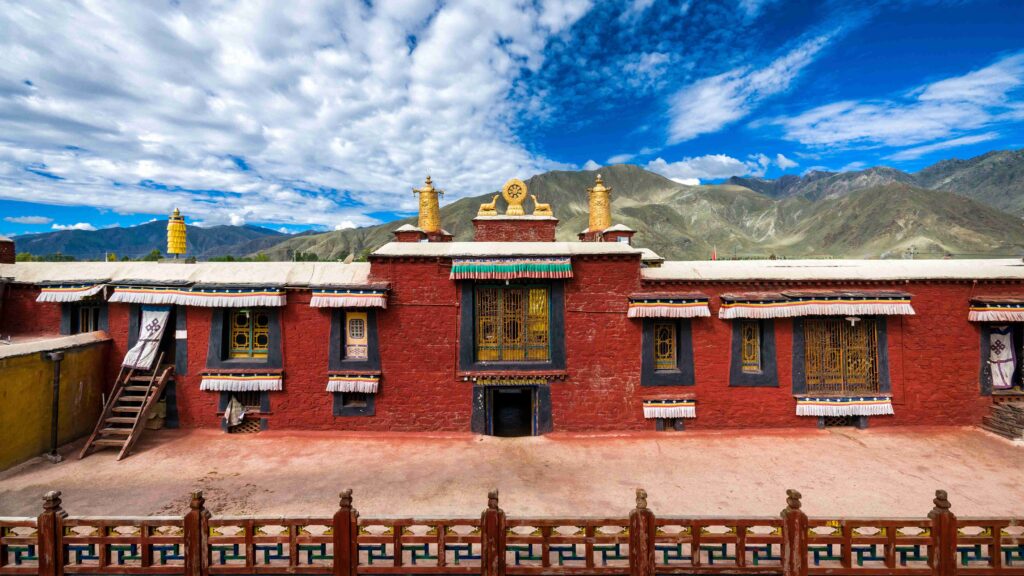
An Essential Guide to Visiting Tradruk Temple
Nestled in the serene landscapes of Nedong County, Tradruk Temple stands as a testament to Tibet’s rich spiritual heritage and historical depth. Often regarded as the first temple in Tibet, this charming monastery invites visitors to step back in time to the 7th century, when it was established by the revered King Songtsen Gampo. A visit here is not merely a sightseeing excursion; it is an opportunity to immerse yourself in the profound tranquility of Tibetan Buddhism and explore a site steeped in legend and artistry.
As you approach the temple, you’ll be greeted by the majestic sight of its traditional architecture, a harmonious blend of cultural significance and natural beauty. Inside, the temple’s walls are adorned with vibrant murals and intricate thangkas that reflect the artistic mastery of Tibetan craftsmen. Notably, the famed Pearl Thangka, said to have been embroidered by the king’s Chinese wife, is a highlight that draws visitors from far and wide. Whether you’re a history enthusiast, a spiritual seeker, or simply a curious traveler, Tradruk Temple promises an enriching experience that resonates with the heart and soul of Tibetan culture.
The temple’s proximity to other iconic attractions, such as Yungbulakang Palace and the Tibetan Opera, makes it an essential stop on your journey through this mystical region. As you make your way through the tranquil courtyards and witness the daily rituals of the resident monks, you’ll find that Tradruk Temple offers not just a glimpse into the past but a living, breathing embodiment of Tibetan spirituality in the present. Prepare to be captivated by its beauty, history, and the warm smiles of its inhabitants as you embark on this unforgettable pilgrimage to one of Tibet’s sacred treasures.
In This Guide
- An Essential Guide to Visiting Tradruk Temple
- The Rich History and Legends of Tradruk Temple
- Main Highlights: What You Absolutely Can’t Miss
- Planning Your Visit: A Practical Guide
- Tickets: Prices, Booking, and Tips
- How to Get There: A Complete Transportation Guide
- Local Cuisine and Accommodation Nearby
- Frequently Asked Questions
- Final Thoughts on Your Trip
The Rich History and Legends of Tradruk Temple
Nestled in the serene landscapes of Nedong County, Tradruk Temple (昌珠寺) holds a significant place in Tibetan Buddhism as one of the oldest temples in the region. Dating back to the 7th century, this sacred site was established by the revered Tibetan king Songtsen Gampo, who is credited with introducing Buddhism to Tibet. The temple’s foundation marks a pivotal moment in Tibetan history, symbolizing the cultural and spiritual awakening that would profoundly shape the identity of the Tibetan people.
Legend has it that Songtsen Gampo built Tradruk Temple as a tribute to his Chinese wife, Princess Wencheng, who brought with her a statue of the Buddha that remains influential in Tibetan spirituality. This temple is often regarded as the first Buddhist temple in Tibet, making it a cornerstone of the region’s religious architecture. Its small, intimate structure stands in stark contrast to the grandiosity often associated with later Buddhist edifices, offering visitors a unique glimpse into the simplicity and devotion of early Tibetan monastic life.
The temple is adorned with intricate murals and thangkas (traditional Tibetan scroll paintings) that depict the life of the Buddha and other significant religious figures. Among its treasures is the famed Pearl Tara Thangka, a masterpiece said to have been embroidered by Princess Wencheng herself. This exquisite artwork, embellished with pearls and precious stones, is considered a spiritual artifact that connects the past with the present, drawing pilgrims and art enthusiasts alike.
Tradruk Temple is not merely a relic of history; it is a living sanctuary of spiritual practice. Monks still conduct daily prayers and rituals, allowing visitors to experience the vibrant spiritual life that flourishes within its walls. The temple’s atmosphere is imbued with tranquility, making it a perfect spot for reflection and contemplation. The massive prayer wheel located at the entrance invites both locals and tourists to partake in the age-old tradition of spinning for good fortune and blessings.
Despite its historical significance, Tradruk Temple is often less crowded than its counterparts in Lhasa, providing an opportunity for deeper exploration and a more personal connection with the sacred space. As you wander through its hallowed halls, the whispers of legends and the echoes of ancient prayers seem to resonate through the air, inviting you to partake in the rich tapestry of Tibetan culture and spirituality.
Visiting Tradruk Temple is not just a journey through history; it is an invitation to witness the enduring legacy of a faith that has shaped the hearts and minds of countless generations. Whether you are a history buff, a spiritual seeker, or simply a curious traveler, the temple offers a unique perspective on the profound impact of Buddhism in Tibet, making it a must-visit destination on your journey through this enchanting land.
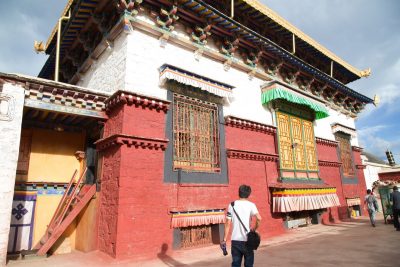
Tradruk Temple.
Main Highlights: What You Absolutely Can’t Miss
Tradruk Temple, often hailed as the first temple built in Tibet, is a captivating destination that offers a blend of historical significance and serene spirituality. Nestled in Nedong County, this monastery is a must-visit for anyone exploring the region. Here are the key highlights you absolutely can’t miss during your visit:
1. Historical Significance
Dating back to the 7th century, Tradruk Temple was founded by the revered Tibetan king Songtsen Gampo, who is credited with introducing Buddhism to Tibet. As one of the oldest temples in the region, it provides a unique glimpse into the early days of Tibetan Buddhism and the cultural exchanges that shaped its development.
2. Stunning Architecture and Murals
While Tradruk Temple may not be large, its architectural beauty is compelling. The temple features an array of vibrant murals that depict the life of the Buddha and various Buddhist themes. Don’t miss the newly repainted murals that enhance the ethereal atmosphere of the sacred space.
3. The Pearl Thangka
One of the temple’s most cherished treasures is the Pearl Thangka, an exquisite piece of art believed to have been embroidered by the Chinese princess Wen Cheng, who married Songtsen Gampo. This thangka, adorned with pearls and precious stones, is located in the upstairs hall and represents a significant fusion of Tibetan and Chinese cultures.
4. Massive Prayer Wheel
As you enter the temple grounds, be sure to spin the enormous golden prayer wheel situated in the courtyard. This traditional practice is believed to spread good karma and blessings, making it a delightful and engaging experience for visitors of all ages.
5. Living Spiritual Center
Tradruk Temple is not just a historical site; it remains a vibrant spiritual center. Observing the monks as they carry out their daily rituals adds a layer of authenticity to your visit. You may witness the offering ceremonies and the serene ambiance that envelops the temple.
6. Intimate Atmosphere
Unlike the more crowded temples in Lhasa, Tradruk offers a sense of tranquility, allowing visitors to soak in the atmosphere without the usual tourist rush. This makes it an ideal spot for reflection and spiritual exploration.
7. Proximity to Other Attractions
Located on the route to significant sites like the Yungbulakang Palace and Tibetan Opera, a visit to Tradruk Temple can easily be combined with other cultural experiences in the area. Make it a part of a day trip to fully appreciate the rich tapestry of Tibetan history.
8. Local Craftsmanship
Before you leave, take a moment to explore the small shops near the temple, which often offer unique local crafts and antiques. This is a great opportunity to pick up a souvenir that resonates with your experience at this historic site.
Visiting Tips:
- Best Time to Visit: The temple is open daily from 9:00 AM to 4:00 PM, so aim to arrive early to beat the crowds and enjoy a peaceful visit.
- Dress Modestly: As with all religious sites, it’s important to dress respectfully. Avoid wearing revealing clothing.
- Photography: While photography is allowed outside, be respectful of the rules inside the temple, where flash photography may be restricted.
Embrace the rich heritage and spiritual significance of Tradruk Temple, and allow its serene environment to leave a lasting impression on your Tibetan adventure.
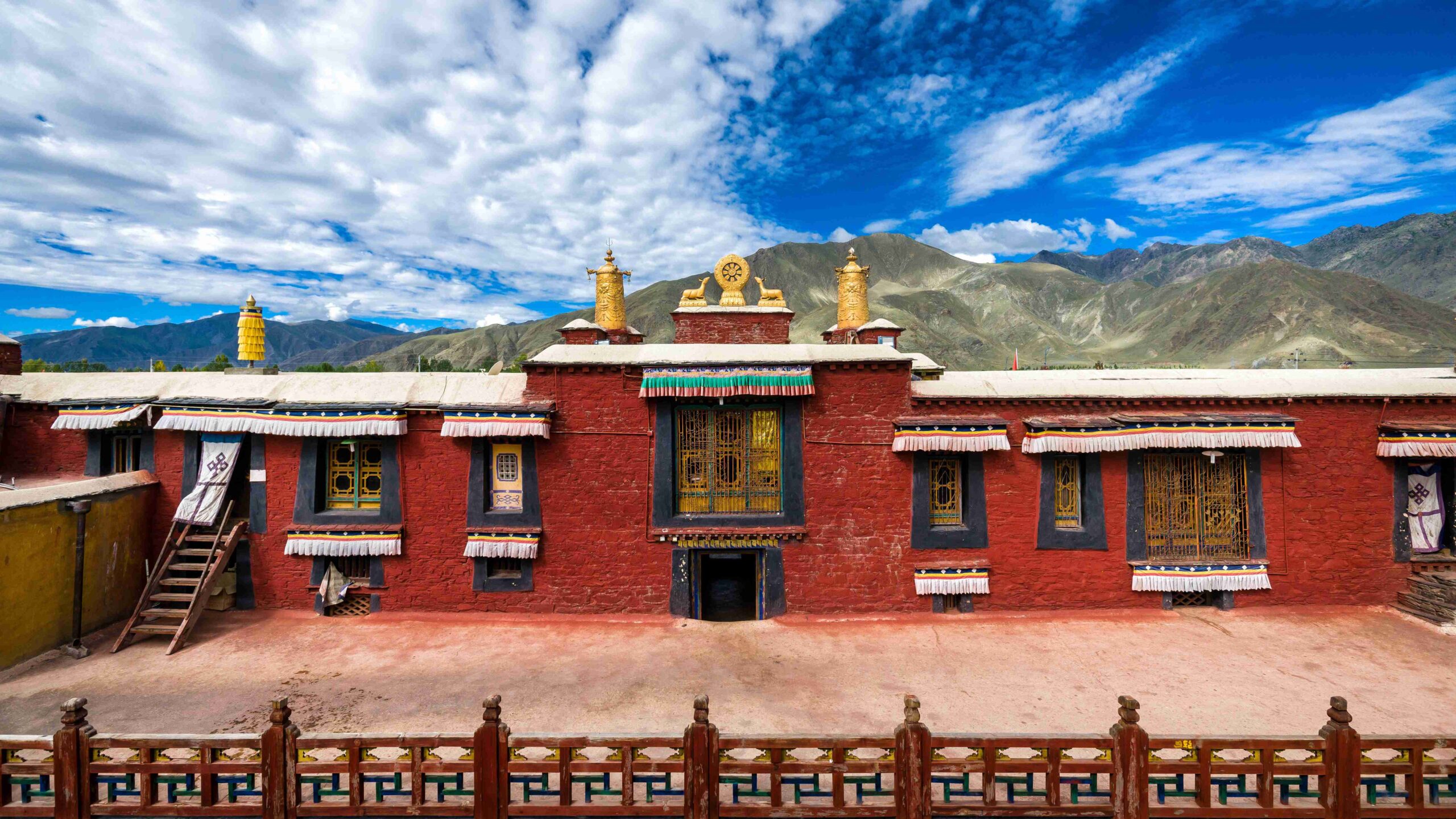
Tradruk Temple.
Planning Your Visit: A Practical Guide
Visiting Tradruk Temple is a remarkable journey into the spiritual heart of Tibet, enveloped in history and rich cultural significance. Here’s everything you need to know to make the most of your visit to this revered site.
Getting There
Tradruk Temple is located in Nedong County, approximately 5 kilometers southeast of Tsedang. If you’re staying in Tsedang, you can easily reach the temple by taxi or local bus, which should take about 15 minutes. For those traveling from Lhasa, it’s about a 2-hour drive, making it a feasible day trip.
Best Time to Visit
The temple is open every day from 9:00 AM to 4:00 PM. To avoid crowds and appreciate the serene atmosphere, consider visiting early in the morning or later in the afternoon. Spring (April to June) and autumn (September to November) are ideal seasons for travel, offering pleasant weather and fewer tourists.
Admission Fees
While there are no specific entrance fees mentioned, it’s always a good practice to carry small denominations of Chinese Yuan for any potential donations or local purchases.
What to See
Tradruk Temple is renowned as one of Tibet’s earliest temples, built in the 7th century by King Songtsen Gampo. As you explore, be sure to look for:
- The Pearl Thangka: A remarkable piece of art said to have been created by the king’s Chinese wife, Wen Cheng.
- Beautiful Murals: Although some have been restored, the murals depicting Buddhist stories and figures are mesmerizing.
- Prayer Wheels: Spin the prayer wheels in the main courtyard for good fortune on your journey.
- Monk Activities: If you visit during a time when monks are present, you might witness their rituals and offerings.
Tips for Your Visit
- Dress Modestly: As a place of worship, it’s important to dress respectfully. Long skirts or trousers and sleeves are recommended.
- Photography: While you can take photos of the exterior and grounds, inside photography may be restricted. Always ask for permission where appropriate.
- Stay Hydrated: The high altitude can be challenging, so drink plenty of water and take your time walking around the temple complex.
- Explore Nearby Attractions: The temple is close to several other sites, including Yumbu Lakang Palace and Gongburi Mountain. Consider extending your trip to explore these nearby gems.
Nearby Amenities
For dining, ZhaXi FanGuan, located about 1.7 miles from the temple, offers Tibetan cuisine and can be a great spot to relax after your visit. If you’re looking for accommodations, various hotels and guesthouses in Tsedang provide comfortable lodging options.
Conclusion
A visit to Tradruk Temple is more than just a sightseeing trip; it’s an opportunity to immerse yourself in the profound spiritual landscape of Tibet. With its historical significance, stunning art, and tranquil atmosphere, your journey to this ancient temple will surely be a highlight of your travels. Prepare yourself for a memorable experience that connects you deeply with Tibetan culture and heritage.
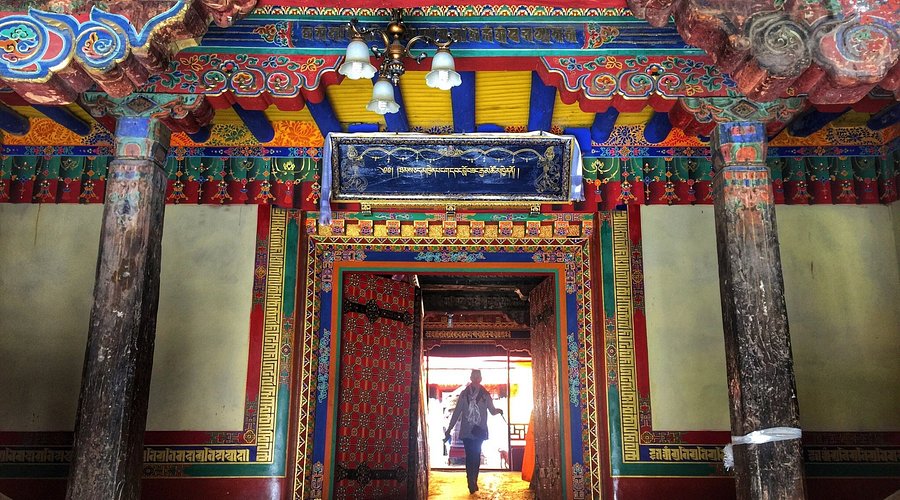
Tradruk Temple.
Tickets: Prices, Booking, and Tips
Visiting Tradruk Temple (昌珠寺) is a captivating experience that offers a glimpse into Tibet’s rich spiritual heritage, and planning your visit is essential for a smooth journey. Here’s everything you need to know about tickets, prices, booking, and helpful tips:
Ticket Information and Prices
Admission to Tradruk Temple is relatively affordable, with tickets typically priced around 30 RMB (approximately $5 USD). This nominal fee grants you access to explore one of Tibet’s oldest temples, steeped in history and architectural beauty.
Booking Your Visit
While tickets can usually be purchased on-site, it’s wise to arrive early, especially during peak tourist seasons, as the temple can attract visitors from nearby areas. The temple is open to the public daily from 9:00 AM to 4:00 PM, so plan your visit accordingly to make the most of your time there.
Tips for Your Visit
-
Time Your Visit: Since Tradruk Temple is less crowded than some of the more famous sites in Lhasa, it provides an intimate atmosphere for exploration. Early morning or late afternoon are ideal times to experience the temple’s tranquility.
-
Dress Respectfully: As a place of worship, it’s important to dress modestly. Comfortable clothing and shoes are recommended, as you may need to climb stairs to access different levels of the temple.
-
Explore Nearby Attractions: The temple is conveniently located on the way to other significant sites like the Tibetan opera and Yungbulakang Palace. Consider planning a day that includes these nearby attractions to enrich your experience.
-
Respect Local Customs: Remember that photography may be restricted in certain areas within the temple. Always seek permission before taking photos, especially of monks or other worshippers.
-
Bring Cash: While some amenities nearby may accept digital payments, having cash on hand is advisable, especially in rural areas where cash transactions are more common.
By keeping these tips in mind, your visit to Tradruk Temple will not only be memorable but also respectful of the cultural and spiritual significance of this historic site. Enjoy your journey into the heart of Tibetan Buddhism!
How to Get There: A Complete Transportation Guide
Reaching Tradruk Temple, one of the oldest and most revered sites in Tibet, can be an adventure in itself, blending scenic beauty with cultural richness. Whether you are traveling from Lhasa or nearby towns, here’s a detailed transportation guide to help you make the journey seamlessly.
Getting to Tradruk Temple
From Lhasa
By Car:
The most straightforward way to reach Tradruk Temple from Lhasa is by hiring a private car or taxi. The drive is approximately 180 kilometers (about 112 miles) and usually takes around 2.5 to 3 hours depending on traffic and road conditions. This route offers stunning views of the Tibetan landscape, making the journey as enjoyable as the destination.
By Bus:
For budget travelers, there are regular buses from Lhasa to Tsedang, the nearest town to Tradruk Temple. Buses leave from Lhasa’s main bus station and take about 4 to 5 hours to reach Tsedang. Once in Tsedang, you can take a local taxi or a short bus ride to the temple, which is about 10 kilometers (6 miles) away.
From Tsedang
By Taxi:
If you’re already in Tsedang, the simplest way to reach Tradruk Temple is by taxi. The journey takes about 15-20 minutes. Taxis are readily available in Tsedang, and the fare is relatively inexpensive.
By Local Bus:
Local buses also operate between Tsedang and the temple. Although less frequent, they offer an authentic local experience. Check the schedule at the Tsedang bus station for the latest information.
Essential Tips
-
Altitude Considerations: Keep in mind that Tsedang is at a high altitude (approximately 3,600 meters or 11,800 feet). It’s advisable to acclimatize properly before making the journey to avoid altitude sickness.
-
Best Time to Visit: The temple is open daily from 9:00 AM to 4:00 PM. The best time to visit is during the spring and autumn months (April to June and September to November) when the weather is mild.
-
Respect Local Customs: When visiting the temple, dress modestly and observe local customs, such as spinning prayer wheels and offering respect at sacred sites.
-
Plan for Limited Amenities: While Tsedang has several accommodation options, dining facilities may be limited near the temple. Consider having snacks or meals in Tsedang before your visit.
Conclusion
Visiting Tradruk Temple is as much about the journey as it is about the destination. Whether you choose the convenience of a private vehicle or the local bus for a more immersive experience, the route to this historical site will reward you with breathtaking landscapes and a deep connection to Tibetan culture. Enjoy your trip!
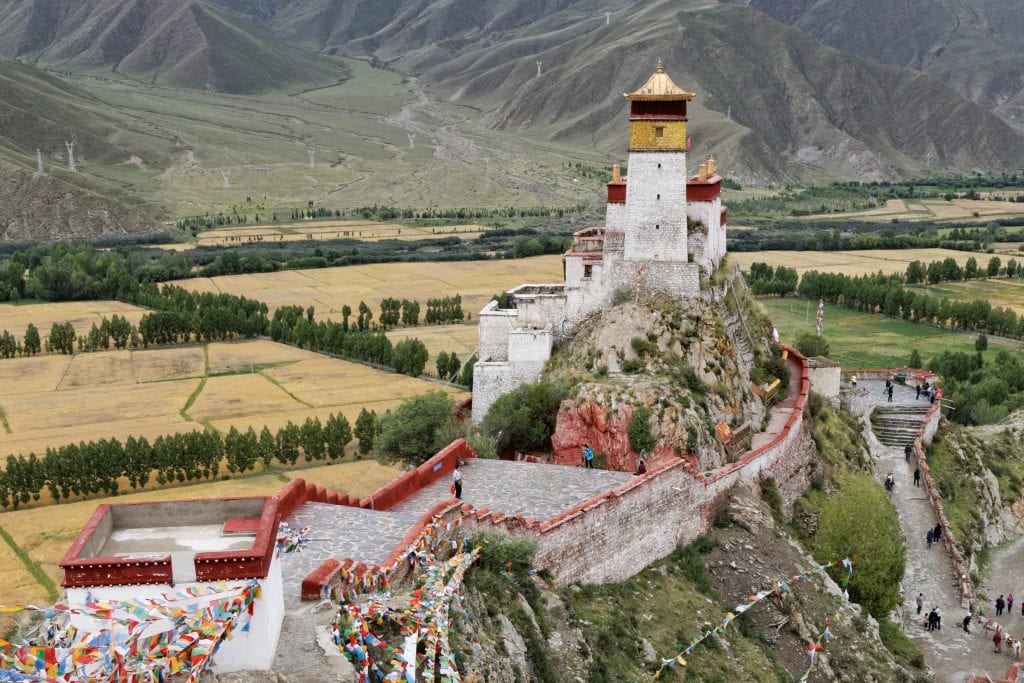
Tradruk Temple.
Local Cuisine and Accommodation Nearby
When visiting Tradruk Temple, the allure of Tibetan culture extends beyond the spiritual realm to tantalizing culinary experiences and comfortable accommodations. Nestled in the scenic Nedong County, this area offers a delightful blend of local flavors and hospitable stays.
Dining Options
ZhaXi FanGuan
Just a short 1.7-mile journey from the temple, ZhaXi FanGuan is a cozy spot that brings the flavors of Tibet to your plate. Specializing in traditional Tibetan cuisine, this eatery is perfect for travelers looking to savor authentic dishes like momos (dumplings) and thukpa (noodle soup). With an inviting atmosphere and friendly staff, it’s a great place to unwind after a day of exploration.
Where to Stay
Nedong County Hotels
For those looking to rest and recharge, several accommodations offer both comfort and convenience near Tradruk Temple. Here are a couple of recommendations:
-
Tsedang Hotel
Located within a short distance from the temple, Tsedang Hotel provides comfortable rooms with stunning views of the surrounding mountains. The hotel features modern amenities while maintaining a traditional Tibetan aesthetic, making it an ideal base for your cultural adventures. -
Shannan Hotel
Another excellent choice is Shannan Hotel, known for its warm hospitality and spacious rooms. This hotel also offers a restaurant that serves a mix of Tibetan and Chinese dishes, allowing you to sample local flavors without venturing far.
Local Tips
While you’re in the area, don’t miss the chance to try Tibetan butter tea—a unique blend of tea, butter, and salt that’s a staple in local diets. Pair this with freshly made barley bread for a truly authentic experience.
Whether you’re tasting the local cuisine or resting at one of the nearby hotels, your visit to Tradruk Temple promises to be enriched by the delightful flavors and comforts of Nedong County.
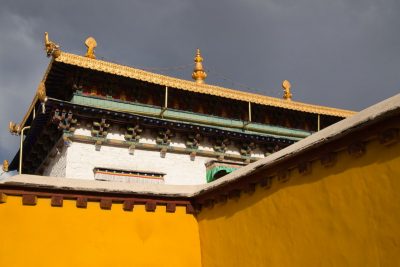
Tradruk Temple.
Frequently Asked Questions
-
What is the historical significance of Tradruk Temple?
Tradruk Temple, believed to be the first temple in Tibet, was founded in the 7th century by King Songtsen Gampo. It holds immense historical and spiritual importance, serving as a symbol of the establishment of Buddhism in the region. -
What are the opening hours for visitors?
The temple is open daily from 9:00 AM to 4:00 PM, allowing ample time for visitors to explore its rich history and beautiful architecture. -
Is there an entrance fee to visit Tradruk Temple?
While specific entry fees can vary, it’s generally a good idea to carry some local currency, as small fees may be charged for temple access or guided tours. -
What should I wear when visiting the temple?
Visitors are advised to dress modestly when visiting Tradruk Temple, as it is a sacred site. Wearing long pants and sleeved tops is recommended to show respect for local customs. -
Are there any guided tours available?
Yes, guided tours are often available, providing deeper insights into the temple’s history, architecture, and significance. Check with local tour operators or your accommodation for options. -
Can I take photographs inside the temple?
Photography policies may vary by area within the temple. Generally, photography is restricted in certain sacred spaces, so it is best to ask for permission when in doubt. -
What other attractions are nearby?
Tradruk Temple is conveniently located near several other attractions, including Yumbu Lakang Palace and Shannan Martyrs Cemetery. Consider planning a day trip to explore these sites as well. -
Is Tradruk Temple accessible for those with mobility issues?
The temple is relatively small, but some areas may have steep stairs and uneven surfaces. If you have mobility concerns, it’s advisable to check in advance or consider visiting with a companion who can assist you.
Final Thoughts on Your Trip
As your journey through Tibet comes to a close, visiting Tradruk Temple offers a unique blend of history, spirituality, and tranquility. Nestled in the serene landscape of Nedong County, this temple stands as a testament to the rich tapestry of Tibetan culture and heritage. Often described as the first temple in Tibet, its humble size belies the profound significance it holds within the Buddhist community.
Here, you’ll encounter stunning thangkas, ancient murals, and the captivating presence of monks engaged in their daily rituals. The atmosphere is imbued with a sense of peace, allowing you to connect with the spiritual essence of this sacred site. As you turn the massive prayer wheel in the courtyard, consider the wishes and prayers of countless visitors who have come before you, each seeking guidance and blessings on their journey.
Whether you’re a history enthusiast, a spiritual seeker, or simply a traveler in search of beauty, Tradruk Temple invites you to pause and reflect. Embrace the opportunity to soak in its ambiance, explore the nearby attractions like Yumbu Lakang Palace, and savor the flavors of local Tibetan cuisine.
As you depart, take with you not just memories of this enchanting temple, but also a deeper appreciation for the resilience and richness of Tibetan culture. May your travels continue to inspire and awaken your spirit as you journey onward.